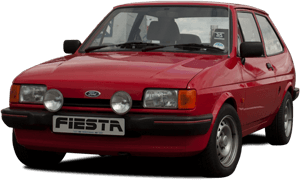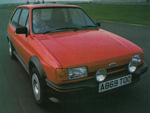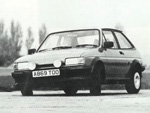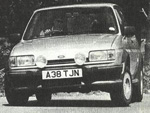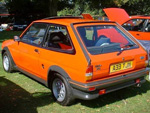In August 1983 the Fiesta mk1 range was replaced by a more rounded mk2 version. The same basic bodyshell was used but given a new smoother front end and re-styled tailgate. As usual Ford chose to hold back the sporty model until the normal range had made its mark on buyers, so no XR2 to be seen. Except for sneak previews in the " Ford Sales Staff only" confidential literature which showed a black left hand drive XR2.
The earliest UK Fiesta XR2 mk2 models to be registered were the Ford press fleet in May 1984, having been built in April 1984 (EG build date code). The press cars were registered A31 to A40 TJN and A869/870 TOO.
The first motoring magazine tests were printed by "Motor" on June 16th 1984 using A38 TJN (silver) and A870 TOO (white) by "Autocar". A869TOO (red), A35 TJN (white), A39 TJN (silver) and A40 TJN (blue metallic) were the other major magazine featured cars. A38 TJN also starred alongside Leslie Ash ( Men behaving Badly, Quadraphenia) in a Tv series called " Cat's Eyes" about a team of lady private detectives.
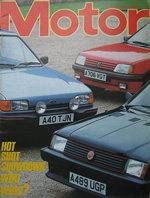
Launch colours were Diamond White, Strato Silver, Glacier Blue, Black and Sunburst Red with the Black attracting an option price of £87.27 and the metallics £101.15. Glacier blue was short lived being replaced by paris blue as was Sunburst red (mk1 XR2 red) which was usurped by Rosso red. At launch the June 1984 Ford Cars brochure listed the XR2 basic price as £5731.
As the XR2 wasn't launched until mid- June 1984 in the UK it only had a little over 2 months worth of sales before B registration on August 1st. But another factor virtually stopped sales in their tracks until B reg had begun. The German market had/has very tough TUV approvals and testing revealed that the exhaust system soundproofing inside the rear box could be made to fail, hence failing noise emission levels, but only by driving the car for 1242 miles ( it was a 2000 km test) at a constant 6000 rpm !!!. To do this the car had to be driven constantly in 3rd gear. The answer was found using similar technology to that found on the body of the space shuttle to counteract re-entry temperatures. Ford Germany tested 3 cars again with 2 reaching 6214 miles ( 10K Km) with intact exhausts. At last they were happy to sell the XR2 in Germany. In the UK this meant that only 165 XR2 mk2 models were registered on A registration plates. Today ( April 2012) only 2A reg examples are known to still exist, both are on sorn and both need major work to return them to the road. One being a"TJN" press cars.
Very early cars differed slightly from late 1984 cars, The most obvious being the seat head rests which were of the "dog-eared" shape wheras later cars had "cylinder" shaped rests. The front seats also had map storage pockets on the back of them. There was also a minor bodywork alteration on the scuttle panel (between screen and bonnet) as original carshad 2 areas of 20 air vent slots but cars built from late 1984 had 2 areas of 27 slots. As such anyone trying to build a "replica" A reg XR2 would get caught out by this small but obvious ( once you know about it that is) change if they used a later bodyshell, and a scuttle panel is not an easy piece of bodywork to replace, but 20 slot panels are not availabe from pattern panel providers anyway.
By all accounts Ford gave the XR2 bodykit manufacturers Marley Foam "hell" over the fit quality, insisting on tolerances that even Ford themselves couldn't work to. Which might explain why there are a couple of subtle differences in the way the rear spoiler and rear wheel arch extensions are fitted on the A reg cars compared with later cars. Any A reg XR2 that does re-appear in future in original unrestored condition could have its provenace proved due to these slight changes. What are they??....sorry but thats staying under my hat until someone appears with the inevitable "barn find".
In August 1986 Ford gave the XR2 a midlife revamp in both the mechanical and interior trim areas. Mechanically the early car had featured a hemi-head CVH 1.6 litre engine using a weber 32/34 DFT carb, but due to new emission laws it was revised to a lean-burn design using a weber 28/32 TLD carb. Performance for the early car was rated at 96 bhp with 112 mph top speed and 8.7 seconds ( optimistic- more like 9.0) to 60. With 60 reached in 2nd gear due to the tall 3.58:1 gearing. Revised cars were still rated at 96 bhp but its widely agreed that it was more like 90 bhp, and because a smaller carb was used Ford lowered the gearing to 3.84:1 to give the car a chance of doing its 109 mph top speed and reaching 60 in 9.3 seconds, but this time in 3rd gear. Other mechanical changes included revised brake servo positioning and a different master cylinder, early cars had a "straight" mounted servo with a long rough cast master cylinder and later cars and a "rising" servo with a stubby black powdercoated master cylinder. This brake revision was mainly because that later cars had a new ignition distributor with the control unit on it making it long enough to hit the early master cylinder. Early cars had a separate ignition module mounted on the nearside engine bay bulkhead.Early models registered in mid 1986 have been found to have the later model brake set up. There is nothing between the two in performance terms, they're both shocking by modern standards!!!!!
Early cars had a black/striped seat material called "rainbow" with grey steering wheel and dash trims wherea later cars had blue/striped "monaco" seats with black steering wheel and dash trim. Centre consoles also changed from the early long cassette draw with remote boot release switch to a small tray version with no remote boot release option - very cheap of Ford really. Boot carpet trim on early cars was grey and became mottled black on late cars. There is also a subtle difference in the shade of grey on door cards and other interior trim between the cars making it a bit of a job these days to get a good clean matching interior when restoring a car. The high level digital clock also got cheap and cheerful with later cars getting an LCD time/day/date unit. Very early cars had green LED time/date/day/stopwatch unit, changing to LCD later. All units were made in grey plastic as opposed to white on the Ghia model.
The cars came as standard on 6Jx13 steel rims with trims and centre caps unless the pepperpot alloys option was ticked. Early steel wheels had slotted holes with an additional 4 holes equally spaced between the wheelbolt holes. Later rins had round holes and no extra holes between wheelbolts. The trims remained the same throughout.
Exhaust tailpipes on early cars featured a neat simple inward rolled round look while late cars had a strange inner pipe protruding out of the end. The systems are not generally interchangeable without minor alteration to the mounting points due to the different position of the early and late fromt downpipes because of the revised exhaust manifold on later cars.
Another anomoly is discovered only when changing from early to late braking systems on a restoration or upgrade. The early pedalbox is not compatible with the later bulkhead linkage as the linkage operating bar hole is in a different position. Use an early pedal box with a late linkage and you can't press the brake pedal...its solid, mechanically jammed.
These are the main differences I have noticed over the 25 years I have owned, worked on and restored these cars.

